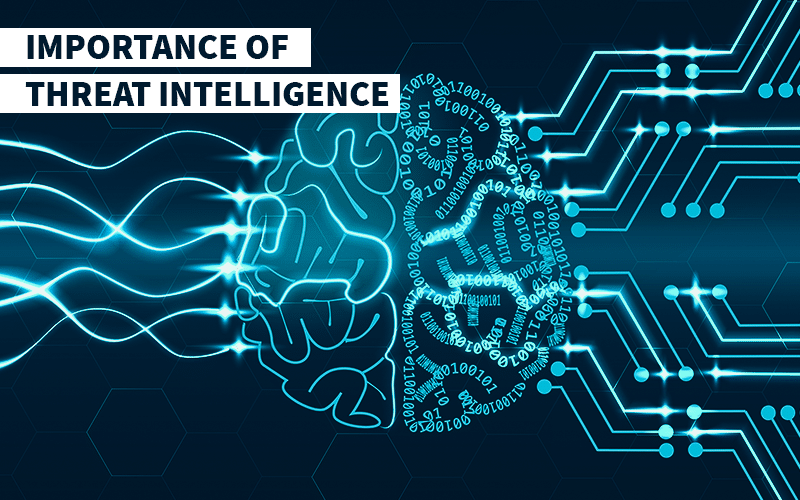
Securing the Weakest Link
July 15, 2019
How SOAR Helps Security Teams Fight Alert Fatigue
July 24, 2019
Securing the Weakest Link
July 15, 2019
How SOAR Helps Security Teams Fight Alert Fatigue
July 24, 2019Importance of Threat Intelligence

With the evolving threat landscape, almost every security analyst believes that a cyber attack is no more a question of ‘if’ but ‘when’. No matter how big or small an organization is, it is not immune to the horrors of cyber attacks. To lower the risk to cyber security of an organization, threat intelligence serves as an added shield to security controls. Threat Intelligence includes acquisition of prior knowledge of cyber threats so that organizations can strengthen their defence mechanisms against on-going cyber attacks. It is acquired through global threat feeds which provide an analysis of on-going global cyber attacks, giving out information like the origin of attack, the source IP address, the malicious domains, URLs used, malwares deployed, as well as the weaknesses of target organization exploited by the attackers.
Need of Threat Intelligence
It is crucial to gather information about potential and on-going cyber attacks to safeguard your assets and secure the integrity, availability and confidentiality of your organization in the digital world. Cyber attacks can not only destroy the reputation of your organization but espionages may go as far as costing you millions for the recovery as an aftermath of a cyber attack. It is therefore important to acquire threat intelligence and prepare for an attack in advance before a threat becomes an incident.
A webroot survey reported that organizations that do not utilize threat intelligence are at a greater risk of cyber attack. The survey also brought forth the following findings:
-
40% of companies surveyed had a material security breach in the past 24 months, of which, 80% believed if they’d had threat intelligence at the time of the breach, they could have prevented or minimized the consequences of the attack.
-
Only 36% of respondents rated their company’s defense as strong.
-
Almost half of respondents said they were increasing the amount of intelligence data they received to prevent or mitigate the consequences of an attack.
-
56% believed that intelligence becomes stale within seconds or minutes, but serves to build the run-time reputation of the source.
-
49% found the free threat intelligence sources to be inadequate and were investing on paid sources for comprehensive threat analysis.
-
One-third of respondents aimed to increase their threat intelligence budget significantly, within the following two years.
Impacts of Cyber Attacks
All cyber attacks aren’t uniform. Some are a matter of a few minutes and yield minimal consequences while others may take years and destroy critical processes of an organization. The impact of each cyber attack is different. Therefore, it is crucial for decision makers to understand the impact of each cyber attack, in order to correctly prioritize and invest their resources on the most critical threats. Threat Intelligence can also be used to learn about the impact of a cyber threat.
Move from Reactive to Proactive Approach
By focusing on the most relevant cyber threats to your organization, you can mitigate against these threats in advance. Without threat intelligence, your cyber security posture remains to be a reactive one, waiting for an incident, a theft or breach in order to work against it. Threat intelligence replaces this approach with a proactive one, through which you can block the chances of a cyber attack in advance. Using threat intelligence, organizations can pinpoint the weaknesses in their infrastructure, which may be exploited in future cyber attacks, and remediate those weaknesses to close entry points for threat actors.
Benefits of Threat Intelligence
Threat Intelligence not only helps prevent cyber attacks, but also helps in recovering from damages in case of an incident. To enhance security posture of your organization, threat intelligence yields the following tangible benefits.
-
Gathering Actionable Data (IoCs)
Threat feeds provide you with Indicators of Compromise (IoC) gathered from analysing cyber attacks globally. These threat indicators include URLs, IPs, email addresses, C2 servers, etc. used in cyber attacks. This data is actionable and can be scanned for in your environment. Together with technical controls, these IoCs will strengthen your defenses in order to prevent the likelihood of a cyber attack.
-
Minimizing Loss of Data
Since Threat Intelligence helps in blocking known malicious domains and IPs belonging to global threat actors, the blockage prevents known threat actors from penetrating your environment using the same malicious IPs and domains. Hence, those attackers can not deploy information stealing malwares or ransomwares in your environment, improving the security of your information.
-
Securing Network Infrastructure
Once a threat actor finds an entry point in your environment, they can crawl through your entire network, using lateral movement and siphoning for important or financial data. By scanning for these IoCs and blocking them in your environment, you can secure your network’s infrastructure and prevent threat actors from proceeding in case they had already entered your environment.
-
Evaluating Security Posture
Threat Intelligence helps evaluate the security posture of your infrastructure. It gives information on the exploitation of vulnerabilities found in different software, tools and applications. Through threat intelligence, you can keep a constant check on what new vulnerabilities are discovered or exploited and check which critical assets are at risk. This way you can apply timely patches or updates to your critical assets as soon as the vendors fix any vulnerabilities or bugs in them.
-
Maintaining Pace with Evolving Modes of Attack
Threat Intelligence also informs on latest modes of attacks. For instance, most attacks these days are being initiated through phishing emails. This intelligence can be used to close entry points for attackers. In the case of phishing, organizations can organize employee awareness programs to block initiation of a cyber attack through successful phishing.
-
Uses of Threat intelligence before, during and after a cyberattack
Not only is this data useful before a cyber attack, but it can also be used to accelerate the recovery process in case a cyber attack occurs. For threat hunting or incident handling, analysts use relevant threat intelligence during an attack as well. It is also used in orchestration and automatic correlation during a cyber attack and helps minimize the time taken to detect an incident. Even after an attack, threat intelligence helps in investigation of the incident, leading to analysis, digital forensics and evidence.
-
Use of Threat Intelligence in Compromise Assessment
Threat Intelligence can also be used to analyze your environment for a compromise assessment. If you suspect that some of your assets have been compromised, you may go for a compromise assessment for a timely recovery of your assets. The assessment will use global threat feeds to analyze the presence of a threat actor in your environment.
-
Sharing of Threat Intelligence Data
Sharing of threat intelligence data helps multiple organizations in fortifying their defenses simultaneously. If a known threat actor plans an espionage, organizations having access to the indicators of compromise for the said campaign can block the indicators and acquire a prior immunity to the attack.
Conclusion
Hence, threat intelligence gives you a visibility of your security posture and alerts you about potential threats coming your way. With this enhanced insight and proactivity, organizations can perform targeted investment of resources and assets for strengthening cyber security in the right direction. It not only helps block incoming threats but also helps mitigate the weaknesses present within your environment.
For implementing threat intelligence, organizations need to gather both local and global threat feeds and then feed the acquired indicators of compromise like malicious IPs, URLs or phishing email addresses to the security controls for detection and blocking.

